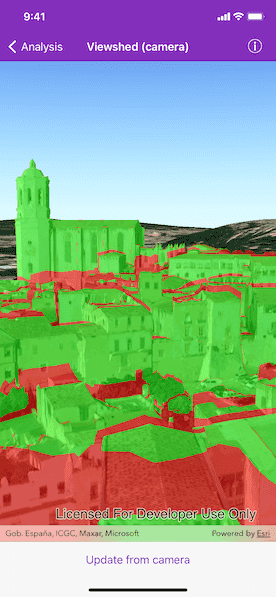Analyze the viewshed for a camera. A viewshed shows the visible and obstructed areas from an observer's vantage point.

Use case
A viewshed analysis is a type of visual analysis you can perform on a scene. The viewshed aims to answer the question 'What can I see from a given location?'. The output is an overlay with two different colors - one representing the visible areas (green) and the other representing the obstructed areas (red).
How to use the sample
The sample will start with a viewshed created from the initial camera location, so only the visible (green) portion of the viewshed will be visible. Move around the scene to see the obstructed (red) portions. Tap the "Update from camera" button to update the viewshed to the current camera position.
How it works
- Create an
AGSLocationViewshed, passing in anAGSCameraobject and a min/max distance. - Get the current camera from the scene with
AGSSceneViewCommon.currentViewpointCamera(). - Update the viewshed from a camera with
AGSLocationViewshed.update(from:).
Relevant API
- AGSAnalysisOverlay
- AGSArcGISSceneLayer
- AGSArcGISTiledElevationSource
- AGSCamera
- AGSLocationViewshed
- AGSScene
- AGSSceneView
About the data
The scene shows an integrated mesh layer of Girona, Spain with the World Elevation source image service both hosted on ArcGIS Online.
Tags
3D, integrated mesh, Scene, viewshed, visibility analysis
Sample Code
// Copyright 2018 Esri.
//
// Licensed under the Apache License, Version 2.0 (the "License");
// you may not use this file except in compliance with the License.
// You may obtain a copy of the License at
//
// http://www.apache.org/licenses/LICENSE-2.0
//
// Unless required by applicable law or agreed to in writing, software
// distributed under the License is distributed on an "AS IS" BASIS,
// WITHOUT WARRANTIES OR CONDITIONS OF ANY KIND, either express or implied.
// See the License for the specific language governing permissions and
// limitations under the License.
import UIKit
import ArcGIS
class ViewshedCameraViewController: UIViewController {
@IBOutlet weak var sceneView: AGSSceneView!
private var viewshed: AGSLocationViewshed!
override func viewDidLoad() {
super.viewDidLoad()
// Add the source code button item to the right of navigation bar.
(self.navigationItem.rightBarButtonItem as! SourceCodeBarButtonItem).filenames = ["ViewshedCameraViewController"]
// Initialize the scene with an imagery basemap style.
let scene = AGSScene(basemapStyle: .arcGISImagery)
// Assign the scene to the scene view.
sceneView.scene = scene
// Initialize the camera and set the viewpoint specified by the camera position.
let camera = AGSCamera(location: AGSPoint(x: 2.82691, y: 41.985, z: 124.987, spatialReference: .wgs84()), heading: 332.131, pitch: 82.4732, roll: 0)
sceneView.setViewpointCamera(camera)
// The URL of the world elevation image service.
let worldElevationServiceURL = URL(string: "https://elevation3d.arcgis.com/arcgis/rest/services/WorldElevation3D/Terrain3D/ImageServer")!
// Initialize the elevation source with the elevation service URL.
let elevationSource = AGSArcGISTiledElevationSource(url: worldElevationServiceURL)
// Add the elevation source to the base surface of the scene.
scene.baseSurface?.elevationSources.append(elevationSource)
// The URL of the scene service for buildings.
let gironaBuildingsServiceURL = URL(string: "https://tiles.arcgis.com/tiles/z2tnIkrLQ2BRzr6P/arcgis/rest/services/Girona_Spain/SceneServer")!
// Initialize the integrated mesh layer with the URL and add it to the scene.
let buildings = AGSIntegratedMeshLayer(url: gironaBuildingsServiceURL)
scene.operationalLayers.add(buildings)
// Create a viewshed from the camera with minimum and maximum distance
// (in meters) from the observer (camera) at which visibility will be evaluated.
let viewshed = AGSLocationViewshed(camera: camera, minDistance: 1.0, maxDistance: 500.0)
// Create an analysis overlay for the viewshed and to add it to the scene view.
let analysisOverlay = AGSAnalysisOverlay()
analysisOverlay.analyses.add(viewshed)
sceneView.analysisOverlays.add(analysisOverlay)
// Store the viewshed for later use.
self.viewshed = viewshed
}
// MARK: - Actions
@IBAction func updateViewshed(_ sender: Any) {
// Update the viewshed with the current camera.
viewshed.update(from: sceneView.currentViewpointCamera())
}
}